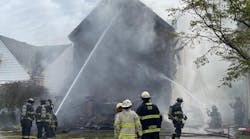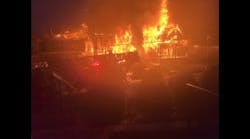On Jan. 23, 2010, at 6:40 P.M., a U.S. Navy T-34 training aircraft was making an instrument flight reading (IFR) approach to New Orleans Lakefront Airport in Louisiana when it disappeared from the airport's radar approximately two nautical miles north of the runway. Airport tower personnel used a computer to model the projected crash site based on the estimated height and speed of the aircraft, placing it about two nautical miles north of the airport approach. Two Marine Corps pilots were on board. U.S. Coast Guard Division 8 immediately launched two 25-foot boats and an HH-65 helicopter to conduct a search of the projected crash area, a two-by-two nautical-mile box.
Surface units searching the area reported that visibility was limited and that neither the city lights nor the airport beacon could be seen from the search area. Within two hours, rescuers reported seeing four distress flares and one of the pilots was soon rescued in good condition. Shortly thereafter, two small boats and a helicopter from the Louisiana Department of Wildlife and Fisheries joined the search, which continued without results through the evening and into the early morning of Jan. 24. That afternoon, Coast Guard Auxiliary Flotilla 48 and the St. Tammany Parish Sheriff's Office lent their watercraft to the search. That evening, USCG Aircraft 6605 spotted debris four to five nautical miles north of the projected crash site. For the rest of the night and into first light on Jan. 25, the search was continued without success.
LOCAL RESOURCES NEEDED
On the morning of Jan. 25, after an exhaustive search that covered 392 total square nautical miles, the rescue mission was called off and turned into a recovery operation. As the Coast Guard is heavily taxed with Homeland Security missions, it was unable to provide the extensive time, energy and resources needed to conduct a prolonged recovery mission. The Coast Guard suggested that the Marine Corps approach local resources to assist with the mission. That afternoon, the call for resources went out to area offices of emergency preparedness, fire departments, and law enforcement and EMS agencies through e-mails, telephone calls and personal contacts. Private agencies such as dive teams also were contacted.
An initial briefing was held at Coast Guard headquarters at 8:30 A.M. on Jan. 26. All responding agency representatives were briefed on the mission so far, the present situation was explained and the agency representatives gave an idea of what resources could be brought to the table. A tactics discussion was held at noon at New Orleans City Hall, where key positions were filled, a firm commitment on resources to be fielded was made and the Emergency Operations Center was officially opened. An initial tactics briefing was planned for 5 P.M.
In the meantime, all major incident command system (ICS) positions were filled, beginning with Marine Corps Major Casey Shea designated as the incident commander. The planning and logistics sections were filled out, and the operations section was set up with Tim Thomasson of the Louisiana Region 1 All-Hazard Incident Management Team as section chief. Dive, surface, shoreline and air branches also were established. Eight agencies volunteered 16 watercraft for the mission. The surface branch director sat down with several members of the Coast Guard Auxiliary who had searched on the previous day and worked out that a four-by-six-mile grid could be effectively worked out by a single search crew. He then asked Kristen Michel of the city Geographic Information Services (GIS) personnel to superimpose a grid of that size over the computer-projected area of the victim's possible location. Thomasson asked the GIS personnel to knock the grids down to three by three miles to facilitate safety and ease and efficiency of search, which resulted in a pattern of 30 grids over the projected area. With 16 boats and three proposed search days, this gave the tactical planners plenty of flexibility. The rest of the night was spent working up the Incident Action Plan (IAP).
On Jan. 25, a private boat from Crowder searching the projected crash site with side-scanning sonar located a tail section in the vicinity, but suspected it was left over from Hurricane Katrina. Thomasson decided to send Gulf State Dive and Rescue, a private dive team, to that location to verify this. The team entered the water at around 4 P.M. At 5 P.M., the Causeway Police reported that their surface radar lost the aircraft approximately one mile north of the projected crash site. This was much more accurate information than was available before and Thomasson had the Crowder boat return to the site to resume the search. When the dive team learned of this, the members volunteered to spend the night as well in case the victim was found.
RECOVERY CONFIRMED
At 10:10 P.M., the Crowder boat located what appeared to be the aircraft very close to the point that the Causeway Police radar lost the aircraft. The Gulf State Dive and Rescue dive team entered the water and obtained a double confirmation of the aircraft by tail number at 2309. At 11:24, the Crowder boat found what was believed to be the victim approximately 70 feet from the aircraft in 15 feet of water. The dive team entered the water, confirmed the sonar alert and recovered the victim by 1:06 A.M. The operation was terminated at 1:09.
Lessons learned:
- The resources unit must aggressively reach out to agencies providing resources to the operation. These agencies should be asked to fill out an ICS 204, Section 6, before they are allowed to participate operationally.
- The "day of" is not the time to come together. A list of local resources should be maintained by emergency services delineating what local resources are available with 24-hour contact lists. The service must get in writing what those resources will bring to the table and what is expected in return.
- The "day of" is not the time to fill key ICS positions. Tabletop training and full-blown exercises should be conducted regularly.
—Ruel Douvillier





